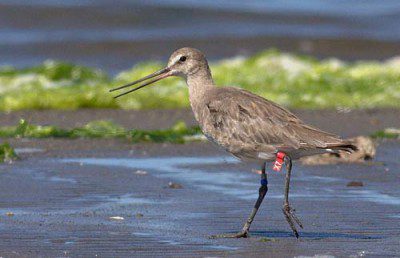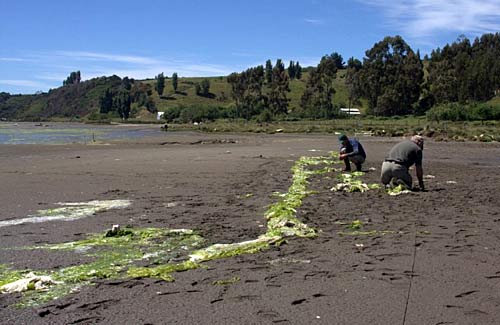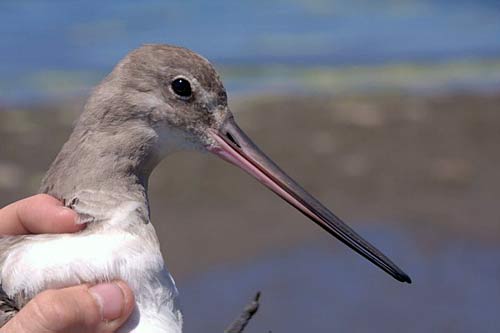Trapping the Godwits of Bahía Pullao
By Nate Senner, Ph.D. candidate
December 22, 2008
We get by with a little help from our friends
After our initial success with Whimbrels, it was time to try for some Hudsonian Godwits, the real reason I had come to Chile, seeing as godwits are the subject of my dissertation. Our hoped-for capture site was the small bay of Pullao, which is tucked into the corner of a small peninsula that extends southeast from Castro, on the eastern shore of the island.
If Isla Chiloé is something of a paradise for godwits and Whimbrels, then Pullao is definitely close to Eden: Despite being small, the bay has thick, gloppy mud that holds an abundance of invertebrate food. And unlike many of the other bays on the island, Pullao has only two houses along its shores and very few disturbances from algae collectors or their wayward dogs.
As a result the place is crammed with godwits. During one scouting trip we counted some 7,400, the largest group that I have ever encountered in one bay on Chiloé. And with a smattering of some 400 Whimbrels present as well, we had high hopes. The only thing that could possibly stand in our way, we felt, was the Southern Caracara—a large raptor that looks like a mix of a falcon and an eagle—that had consistently harassed the godwits during our attempts at Pullao in the past.

On this day, though, no Southern Caracara showed its face and everything began to unfold perfectly. First one of our team members went and stood at the only other possible roosting site on the bay. Birds immediately picked up from there and flooded the area near our nets. With that auspicious beginning, we felt that all we had to do was wait for the tide to push enough birds up into our capture zone for a good catch. But 50 minutes later, most of the flock seemed content to stay where they were, even as the rising water began to wash around their feet.
As high tide drew nigh, we began to get nervous. What else could we do though? There were so many birds crowding the area that twinkling them (see my previous post) would probably just spook them into flying as opposed to moving them toward the net. And, obviously moving the net wasn’t possible either! So instead, we just sat there and began to fret.

Just as time was running out, I noticed a large piece of polystyrene foam – likely from the local aquaculture industry – bobbing along the shore toward the flock. At first I was worried this might scare the birds away and ruin our chances completely. Instead, the flotation device acted as the perfect twinkler, gently herding the birds down the shore toward the nets! Within 10 minutes the job was done and we had nearly 200 birds in the capture area. This was just too good to be true, and we knew we had to act quickly. Thankfully this time, when Larry counted “3, 2, 1, fire,” everything went according to plan. The net fired and we all ran madly down the beach.
The catch was 156 godwits, 4 Whimbrels, and 1 Red Knot (an unexpected bonus and only the third we have ever captured on Chiloé), making us a very happy crew. 156 birds was nearly our largest catch ever, and brought our total number of godwits caught over the past three years to over 500. We could scarcely hope to be so lucky every time, but we still have our fingers crossed for our next goal of placing three satellite transmitters on Whimbrels back at our first capture site, Chullec. Check back in a couple of days and I’ll tell you how it went.

All About Birds
is a free resource
Available for everyone,
funded by donors like you
American Kestrel by Blair Dudeck / Macaulay Library
